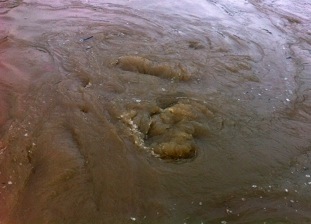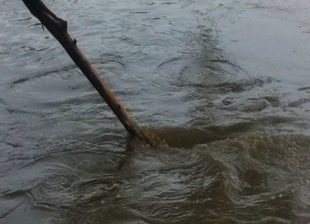Turbulence is often presented as “the last unsolved puzzle of classical physics”, probably as a sort of hyperbole designed to compete with the hyperbole commonly used to describe particle physics. Perhaps a more useful analogy is turbulence as its own state of matter. Certainly the turbulent state is readily observed all around us and does have peculiar and unique features. For example it mixes fluid properties like temperature and chemical concentration very efficiently. It is also very nearly self-sustaining through the mechanism of vortex stretching. Think of the two pictures above taken of the local river at spring flood. The one on the right, with flow from left to right past a stick, has clear features associated with the waves, the spray that results from their breaking and other less coherent features generated by the disturbance to the main flow that the stick induces. However, even in this picture disturbances not associated with the stick are evident. In the picture on the left, there is no clear causal mechanism. What I tried to capture are the boils, or kolks, on the surface as coherent vortices impact the free surface from below. These occurred quasi-periodically and the whirlpool like features ranged in size from a centimeter or so to several tens of centimeters.
Of course these are only the fluid motions that are possible to see with the naked eye. In fact we now know that in a turbulent flow, vortices exist with sizes ranging from the scales on which energy is injected into the flow down to miniscule scales (the Kolmogorov microscale) at which dissipation into heat takes place. This is what is meant by a many degree of freedom system, and the difficulties in formulating an intuitive, yet predictive physical theory for such systems is the central puzzle of turbulence. Modern computer simulations consistently increase the resolution with which we can probe artificial turbulence (though we are still a long way from a river inside a computer) and provide an efficient experimental tool with which to probe this state of matter.
Turbulence and many degrees of freedom





